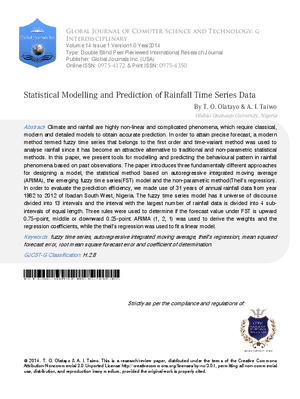Abstract
Climate and rainfall are highly non-linear and complicated phenomena which require classical modern and detailed models to obtain accurate prediction In order to attain precise forecast a modern method termed fuzzy time series that belongs to the first order and time-variant method was used to analyse rainfall since it has become an attractive alternative to traditional and non-parametric statistical methods In this paper we present tools for modelling and predicting the behavioural pattern in rainfall phenomena based on past observations The paper introduces three fundamentally different approaches for designing a model the statistical method based on autoregressive integrated moving average ARIMA the emerging fuzzy time series FST model and the non-parametric method Theil s regression In order to evaluate the prediction efficiency we made use of 31 years of annual rainfall data from year 1982 to 2012 of Ibadan South West Nigeria The fuzzy time series model has it universe of discourse divided into 13 intervals and the interval with the largest number of rainfall data is divided into 4 sub-intervals of equal length Three rules were used to determine if the forecast value under FST is upward 0 75 point middle or downward 0 25-point ARIMA 1 2 1 was used to derive the weights and the regression coefficients while the theil s regression was used to fit a linear model The performance of the model was evaluated using mean squared forecast error MAE root mean square forecast error RMSE and Coefficient of determination The study reveals that FTS model can be used as an appropriate forecasting tool to predict the rainfall since it outperforms the ARIMA and Theil s models
This work is licensed under a Creative Commons Attribution 4.0 International License.
Copyright (c) 2014 Authors and Global Journals Private Limited

